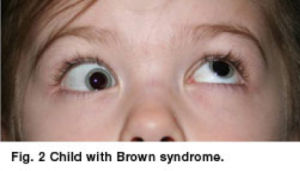What is Brown syndrome?
Brown syndrome was first described by Dr. Harold W. Brown who originally described it as “Superior Oblique Tendon Sheath syndrome” (see figure 1). Calling this a “syndrome” is a misnomer in that the problem is isolated to the eye—specifically the superior oblique muscle/tendon and the trochlea. It is a mechanical problem where the superior oblique muscle/tendon is unable to freely pass through the trochlea and becomes restricted. Essentially the affected eye is “tethered” or held down by the tight superior oblique tendon. It is most noticeable when the affected eye is looking in towards the nose and up. A Brown Syndrome is most commonly congenital, or present at birth, but may be acquired, or begin later. It is most commonly in only one eye and interestingly more common in the right eye than the left for reasons that are unknown.
What do the eyes of patients with Brown syndrome look like

The eyeball itself appears normal but its movement is restricted when looking in towards the nose and up. The eye misalignment is most noticeable when the affected eye looks towards the nose. It appears to look down or straight ahead while the unaffected eye looks up (see Figure 2). Although this is typically not uncomfortable, it can cause double vision and hence will be avoided by the child. For this reason, patients with a Brown syndrome will occasionally hold their chin up or turn their head to avoid looking in the direction that causes their eyes to misalign. Often the higher eye is mistakenly presumed to be the abnormal eye, but it is actually the lower eye that is affected.
What causes Brown syndrome?
Despite a substantial amount of research which has helped us better understand Brown Syndrome, the cause is often unknown. Most commonly it is congenital, meaning a child is born with it. Acquired Brown syndrome is uncommon but may be seen following surgery, after trauma, sinus infections or in association with inflammatory diseases. Trauma can cause a Brown Syndrome if a blunt object hits the eye socket in the upper inside corner near the nose. Surgery for the eyelid, frontal sinus, eyeball (retinal detachment) and teeth (dental extraction) have also been linked to acquired Brown syndrome. Inflammation of the tendon-trochlea complex (from adult and juvenile rheumatoid arthritis, systemic lupus erythematosus and sinusitis) can be associated with development of the problem. The actual cause of the restriction of the superior oblique at the trochlea is likely different in all of these situations.

Is Brown syndrome hereditary?
Hereditary cases of Brown syndrome are rare. Most cases arise without a family history (sporadic).
Is Brown syndrome hereditary?
Hereditary cases of Brown syndrome are rare. Most cases arise without a family history (sporadic).
How is Brown syndrome diagnosed?
The most common way this is detected in children is that parents will notice the child holds a head turn or chin up head position to compensate for the Brown syndrome. When the child looks up at the parents they will see the eye misalignment that is in figure 2. Often the Brown Syndrome may be so mild that it is not noticed for several years. In these cases the eyes are typically not affected when looking straight ahead and often don’t require treatment. The hallmark sign of Brown syndrome is a decreased ability to look upward and inward with the affected eye(s). In some situations the eyes turn outward (exotropia) when looking up. Occasionally, the affected eye can get “stuck” after looking up or down for long periods of time. When the eye becomes unstuck, a click is often heard and may be accompanied by pain or discomfort. Brown syndrome may be more noticeable in children since they often look upward toward adults.
Does Brown syndrome affect one or both eyes?
Ninety percent of patients have only one affected eye, more commonly the right.
Does Brown syndrome cause eye problems besides abnormal eye movements?
In the more severely affected cases of Brown syndrome, some children will have poor binocular vision which can result in poor depth perception and/or amblyopia. This is because the child is unable to align the two eyes looking straight ahead or with a compensatory head position.
Are there different kinds of Brown syndrome?
Brown syndrome can be classified according to severity. In mild cases there is only a reduced ability to look up and in with the affected eye. In moderate cases, there is also a tendency for the eye to move downward as it moves inward. In severe cases there is a tendency for the affected eye to turn downward when the patient looks straight ahead.
Can Brown syndrome improve or resolve without treatment?
Spontaneous resolution can occur in both acquired and congenital cases. In congenital cases, the eye movement problem is usually constant and unlikely to resolve spontaneously.
How is Brown syndrome treated?
Treatment recommendations for Brown syndrome vary according to the cause and level of severity. Close observation alone is usually sufficient in mild cases. Visual acuity and the ability to use both eyes at the same time (binocular vision) should be monitored closely in young children. Nonsurgical treatment is often advised for recently acquired, traumatic and intermittent cases. Systemic and locally injected corticosteroids have been used to treat inflammatory cases of acquired Brown syndrome. Non-steroidal anti-inflammatory agents (like ibuprofen) have also been used. Surgical treatment is usually recommended if any of the following are present: eye misalignment when looking straight ahead, significant double vision, compromised binocular vision or pronounced abnormal head position. More than one surgery may be needed for optimal management.
Credits: Journal of American Association for Pediatric Ophthalmology and Strabismus